How To Write A Blog For Small Business

There was a pivotal time a few years ago when I realized I was an actual imposter.
My branding agency was helping businesses successfully build a brand by publishing exceptional content on their blogs.
But making excuses for not doing our own.
It's a classic scenario—you're fixing shoes for everybody else, and have holes in yours.
So I put my good shoes on (Converse low-tops), took action, and created my own content marketing plan.
Laser-focused on business blogging.
What do you think happened next?
In the first few months of publishing long-form blogs, our organic traffic skyrocketed from 300 visitors to 3,000 (about a 420% increase).
Fast forward to today, we're surpassing 55,000 pageviews a month—and growing.
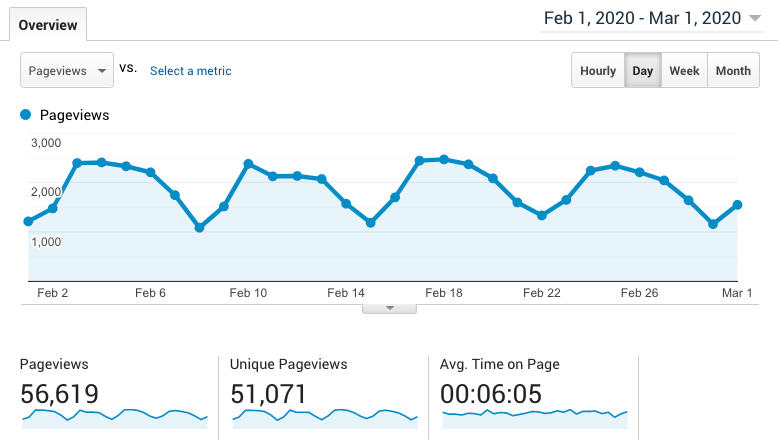
You know what that means: ongoing brand awareness, tons of new leads, and great new branding projects for us to work on.
*happy dance*
I'm confident you can see these kinds of results as well.
How?
The key to being recognized as an authority in your industry and becoming a "go-to" resource, is to create a successful blog for your business.
If you're wondering how to start a blog, then you're in the right place!
Here's the deal:
Valuable blog content helps gain trust and loyalty for your brand.
With the right blog article content, you can stand out from the competition as a knowledgeable expert in your niche.
Timely and relevant content helps develops a relationship with your target customer. Eventually, they will come looking to purchase something or hire you for services.
Even better—content marketing gets three times the leads over paid search advertising.
In fact, 70% of people would rather learn about a company through blog articles rather than by seeing an ad.
Case in point: the majority of potential clients who contact my company have come after reading our epic brand building blog post.
In 2020, you simply cannot ignore the benefits of blogging for your business.
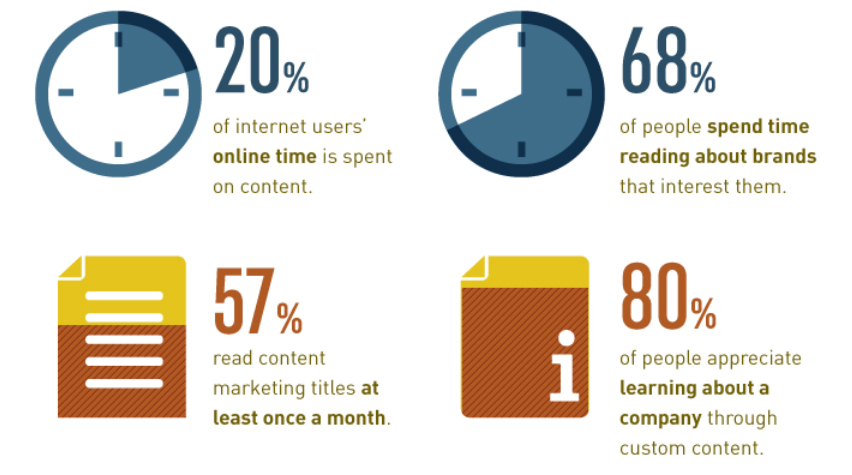
Source: Demand Metric
And here's more validation:
- 20% of internet users' online time is spent on content.
- 68% of people spend time reading about brands that interest them.
- 57% read content marketing titles at least once a month.
- 80% of people appreciate learning about a company through custom content.
So what is content marketing, exactly?
In a nutshell, content marketing is about telling a story that connects with a consumer. It's less about selling and more about relationship building through sharing information which solves a pain point.
A blog is the perfect way to do this!
Now, blogging for beginners can be a daunting activity given the commitment needed.
But not to worry; I'll prepare you for success.
In this article, I'm answering the question of how to blog for your business, by asking YOU seven important questions to get started.
But first, let's quickly go over how you can set up the actual website for the blog.
(If you already have a blog on your website, skip down to Step #5.)
Starting a Business Blog: The Setup
EXISTING WEBSITE
For an existing website with no blog, you'll first want to check what capabilities your CMS (content management system) has for blogging.
If you are on WordPress, jackpot.
WordPress was originally created as a blog platform. Although the features are so much more robust now, it is THE best platform for blogging.
Not only is WordPress geared for SEO (search engine optimization—so that your site pages can be found on Google via search), but the interface for writing blogs is easy-to-use. It's our favorite website management system to use and develop on.
You can find tutorials to help you add the component to your WordPress site. Just Google it.
If you are not on WordPress (maybe you have Squarespace or Shopify), find out from the provider about how to add the blog to your website.
NEW WEBSITE
Here are the steps to take if you are just starting out without any website or blog:
Step #1 – Register the domain
The first step in creating a website with a blog is registering the domain (the .com, .net, .org, etc). You can search available domains to find the best match for your brand name, and then secure it with the GoDaddy domain registration service.
Even if you are in the early stages of planning your brand, invest in this if you have a brand name. Domain names are getting snatched up by the minute. GoDaddy will upsell you with web hosting for your domain. However, we recommend a better solution from another provider (see below).
If you already have a domain, go straight to Step 2.
Step #2 – Sign up for web hosting
Next, you need to host the website securely. As mentioned, we build the majority of all websites with blogs on WordPress. When you have a content management system with databases and plugins, it's best to have web hosting that specifically caters to the platform.
Bluehost specifically provides WordPress hosting, with amazing customer support.
Do not skimp out on your web hosting, friend. It's worth the investment for a top-notch provider in this department.
The Bluehost WordPress Shared Hosting plans start at $3.95 a month, you can't beat that price for the quality. They'll help you get your domain set up on the hosting server space you secure from them. In the navigation, go to WordPress > WordPress Hosting.

Step #3 – Choose a WordPress theme
Finally, pick the design and user experience you like the best for your blog.
Once you've completed your account set up with Bluehost, and picked a WordPress theme from them, your new account is automatically connected to the latest version of WordPress. Login to your customer dashboard and find your new site waiting for you to start editing.
If you need help or would like guidance on creating, designing, or promoting your new blog, you can contact the Bluehost team of WordPress experts (available 24/7). They will help you every step of the way.
Step #4 – Explore other WordPress themes
If you are picky and not finding a free WordPress theme that you like on Bluehost, then the next solution is to find a paid theme.
If you want an awesome-looking WordPress website design theme for your brand that is great for SEO, mobile-friendly and loads fast, get one from StudioPress. All themes look great out-of-the-box but can also be highly customized if needed. You'll need to install this theme onto your Bluehost web hosting space, but they can walk you through that.
Step #5 – Create clear goals for blogging
Here comes the fun part.
Setting goals for your blog and blogging efforts will give you the best way to measure progress.
It will also help you stay motivated to stay consistent with blogging, because you'll be guided by your purpose. You can even create a thorough seo content brief using these goals when working with freelance writers or agencies for your content. Do this after you get through setup, but before you start writing and publishing.
Want to know how to set those important goals?
Let's get into it.
How to Blog For Business With the Right Goals
The face of marketing changes quickly, especially as technology takes over our everyday lives. Gartner predicts that by 2020, customers will manage 85% of their business relationships without human interaction.
It's no surprise that communicating without traditional interaction requires consistent online content publishing to convey your message—and market your brand.
The solution is to start blogging for business growth—but with intention.
Blogging for the sake of blogging is not a good use of resources or time.
Unfortunately, you will not just magically end up with a successful blog for your business that drives tons of traffic and new customers.
You need to create clear goals for blogging that will give you vision, purpose, and a way to measure results.
Answering these questions will get you there.
1. Why are you blogging?
Before you even begin writing anything, ask that question of the hour: "Why?"
Why is it important for your brand to have a blog?
It's not just because professional marketers say that blogs are the most valuable type of content marketing…is it?
It's not just because you are looking at monetizing a blog…right?
If you are only wondering how to make money blogging, do a gut check.
Blogging for business will result in sales. But to start a blog, you need a clear purpose that focuses mainly on the consumer.
A few things you can consider when establishing the "why" behind your business blog:
- Are you trying to help solve problems or pain points with your blog?
- Is the blog meant to illustrate your skills or expertise in a particular niche?
- Are you using your blog to improve your SEO for a certain topic?
- Is the blog meant to improve your bottom line, or generate brand awareness?
Are you blogging for a specific purpose? Find your 'why' for writing. Click To Tweet
Once you understand the purpose of your business blog, you can better organize and share your content in a way that meets both your business needs and the needs of your readers.
2. Who is your target audience?
Remember the first season of the show Mad Men? The advertising company tries to sell bras from a man's perspective.
They forgot their audience. Men don't buy bras. Women buy bras. Their ad campaign had to work for women, not men.
Your brand's blog audience holds equal importance.
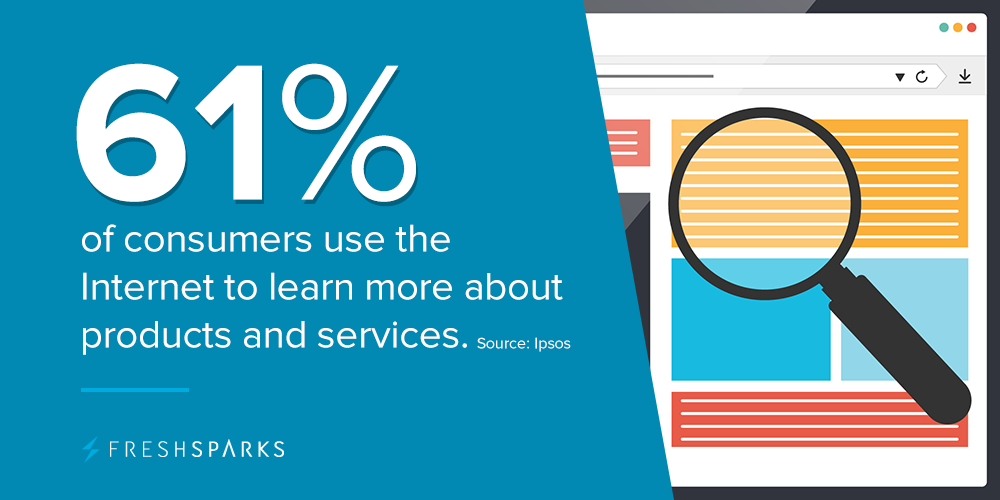
61% of consumers use the Internet to learn more about products and services.
To reach them, you need to know them.
And, your audience is not just a two-dimensional man vs. woman. A successful blog is written with a clearly defined reader persona in mind.
To determine your target audience, find out answers to the following questions:
- What is the gender, age and income of my perfect audience?
- Where does my ideal audience member work, and what do they do for fun?
- In what area does my audience want to grow and improve? Do they face challenges and have pain points?
- Where does my audience get information, and where do they spend a lot of time (online and offline)?
When you determine who your target audience exactly is, learn how to write a blog post specifically for them.
61% of consumers use the Internet to learn more about products and services. Click To Tweet
3. What value does your blog offer?
What you offer your readers goes back to why you're writing your blog in the first place.

82% of consumers feel more positive about a company after reading custom content.
Readers and consumers are not going to flock to your blog unless you have something of value to provide.
For success in digital marketing, you have to give first if you want to receive. This means that traditional, "Buy this!" advertising does not work for blogs.
When writing content for your blog, offer readers something other than self-promotion.
- Are you giving them insight that they can't find anywhere else?
- Are you solving a problem?
Understand that even if all your blog offers is something intangible like great advice or thought leadership, you're still giving something. And chances are it's valuable, not to mention free!
Adding to the online knowledge database is a great step toward building a successful blog for your business. Determine what unique value you can contribute.
82% of consumers feel more positive about a company after reading custom content. Click To Tweet
4. What voice and tone does your blog use?
When you seek the answer for, "how to create a business blog", voice and tone play a big role.
How you articulate your brand and ideas is crucial.
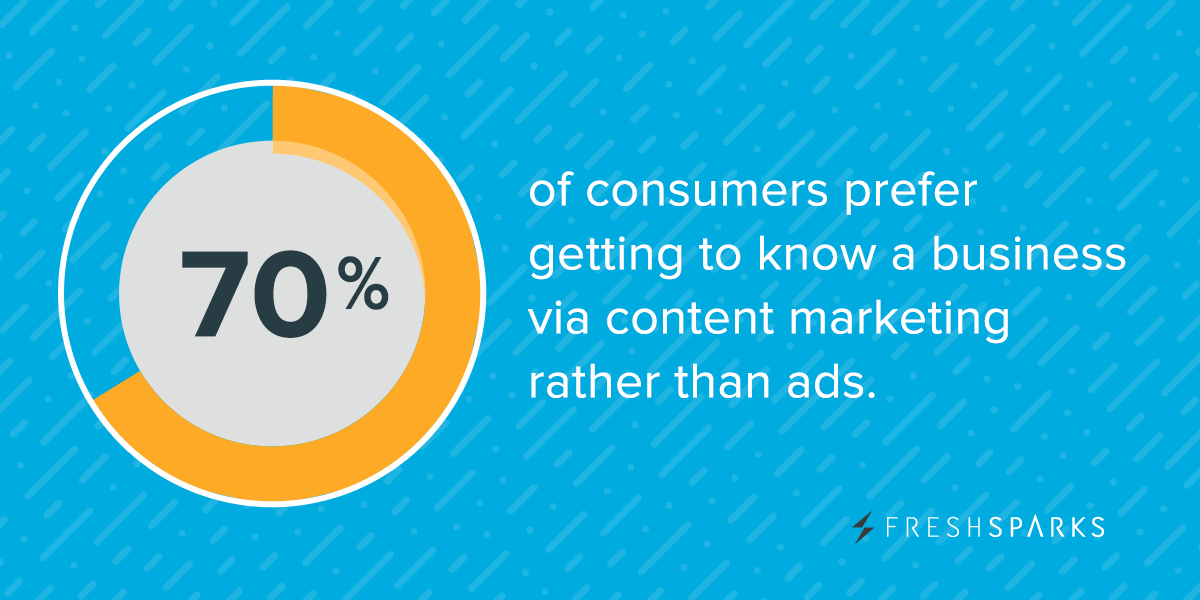
As mentioned previously, 70% of consumers prefer getting to know a company via content marketing rather than ads.
Blogging for business is your opportunity to virtually shake hands and introduce yourself.
If your blog uses confusing language, a boring tone, and an arrogant voice, then that's the image you'll portray to your readers.
Choose a tone and voice that matches your brand building and target audience.
SEE ALSO: 11 Simple Steps For A Successful Brand Building Process
If your audience is composed of Millennials, then your blog may need to be direct, fun, and personal.
If your brand is an up-and-coming tech company, your blog could be witty, educational, and cutting edge.
Keep in mind that every successful blog is unique.
If the subject of your blog is serious in nature, but your website is lighthearted, it's appropriate to change your voice to match the topic.
When blogging for branding, always be consistent in writing articles that match your brand in subject, tone, or voice.

5. How will you measure success?
Building a successful blog can only be deemed a success if you can show ROI.
For some companies, ROI comes back to customer acquisition.
Metrics that illustrate success come back to why you are writing your particular blog, and what you are offering the reader.
SEE ALSO: 19 Important Metrics for Measuring Digital Marketing Success
If you write your business blog to improve your SEO rankings on Google, then the following metrics are important to measure:
- Blog readership
- Page rank based on your SEO focus keyword(s)
- Organic website traffic to the blog page
- Outbound and inbound link clicks
However, if your goal is to increase purchases of a specific product or service, your key metrics could include:
- Sales calls to a direct phone number
- Link clicks on a blog URL
- Email subscribers
- Product conversions
Whatever focus you choose to measure, always create S.M.A.R.T goals. These are specific, measurable, achievable, results-focused, and timely.
It's helpful to break up goals into tiered time frames: such as yearly, quarterly and monthly. This way, you can meet milestones as you go along and feel accomplished enough to continue.
Assign specific details and numbers to your goals.
Instead of thinking:
"I'm going to post content every month to my blog",
try this:
"I'm going to post 1 keyword-optimized, 1,500-word evergreen blog article per week for 52 weeks".
Break up blog goals into tiered time frames: yearly, quarterly and monthly. Click To Tweet
Remember that each blog can and should have different measurements for success, but you should also strive for consistency.
Only by measuring the same key metrics for every blog, can you determine which topics, goals, and offers are the most successful.
6. What action do you want your readers to take?
Every business blogging effort can benefit from a single, often simple, call-to-action.
The action your readers perform is the easiest measure of how to build a successful blog.
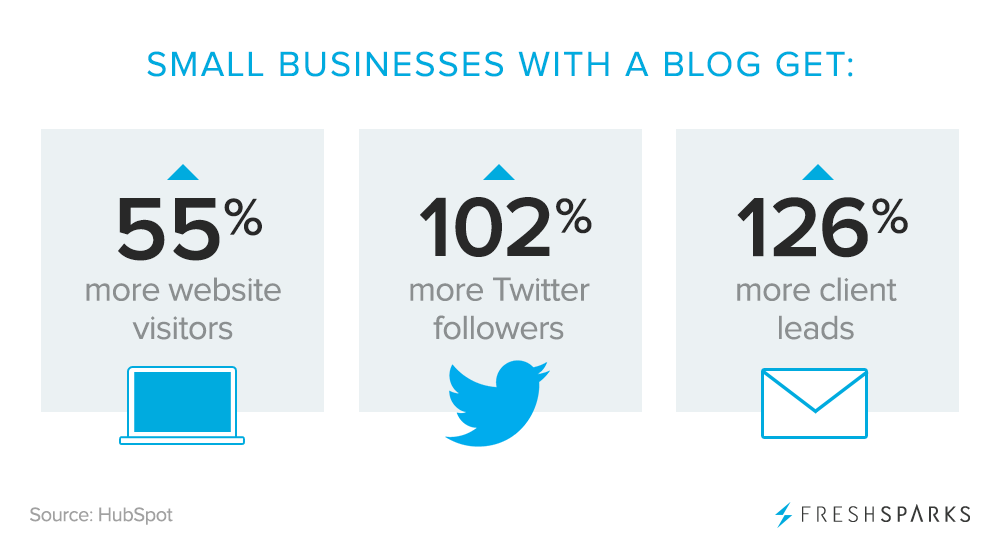
When trying to come up with your call-to-action, think about the fact that small businesses with a blog get:
- 55% more website visitors
- 102% more Twitter followers
- 126% more client leads
Your call-to-action can be anything, but it should roll back to "why" you blogged, your target audience, and what you offer your readers.
See how all these pieces always work together?
The action your readers perform is the easiest measure of how to build a successful blog. Click To Tweet
Potential calls to action ideas include:
- Download a free report
- Sign up for an email list
- Register for a webinar
- Follow on Twitter (or insert other social network)
- Visit the services page
- Buy a product
- Leave a comment
The exact language which makes up these CTAs can vary, but the idea is to tell your users exactly what to do when you have their attention.
Going without a clear call to action on your website's blog design would be a big mistake. Think about it carefully!
SEE ALSO: 5 Most Common Web Design Mistakes to Avoid Right Now
Small business websites with a blog get 55% more web visitors and 126% more leads. Click To Tweet
7. How will your blog gain exposure?
The final secret for how to start a business blog in 2021, is to remember that your work doesn't stop after you've written your blog.
A successful blog is not one that no one has read. Instead, the goal of every blog should be to gain exposure.
Of course, this requires even more marketing and promotion.
According to Hubspot, companies that blog have 97% more inbound links, but these links don't happen by accident. Every blog requires:
- A focus keyword to drive organic exposure from search engines
- Backlinks to illustrate your relevance
- Research and thought leader quotes to demonstrate your knowledge
And after you write your blog, you need to promote it on social media, other blogs, and your website.
Each post will need consistent and persistent promotion over time.
Follow a queued schedule of messages posted to your active social networks.
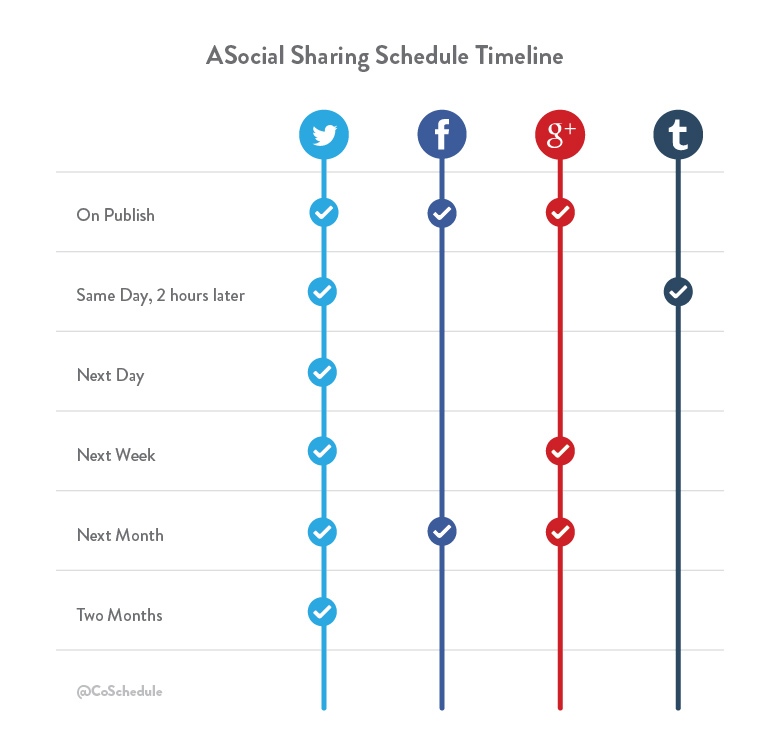
Create more than one social media post message using variations in the headline, image, and hashtags.
SEE ALSO: 7 Effective Social Media Best Practices for Business
To make your promotion successful, your blog articles need:
- Compelling headline/title
- Focus keywords
- Optimized meta description and URL tag
- Shareable content (text quotes and/or images)
- Social sharing buttons
The best exposure occurs when all the pieces fall seamlessly together.
SEE ALSO: Blogging for Beginners: 40 Tips to Grow Blog Traffic
Companies that blog have 97% more inbound links. Click To Tweet
Conclusion
The single most important source for leads in my business is our blog. But for that to happen, you need to create a plan for business blogging.
You don't want to just throw your blog content against the wall and hope it sticks!
Instead, learn how to start a blog for your business after answering the seven questions in this article.
- Why are you blogging?
- Who is your target audience?
- What value does your blog offer?
- What voice and tone does your blog use?
- How will you measure success?
- What action do you want readers to take?
- How will your blog gain exposure?
By putting in the time and effort to outline goals and a plan for business blogging, you'll find a far greater return on your investment. What this simply means for you is more credibility, traffic, leads and ultimately sales!
Setting blog goals will give you vision, purpose, and a way to measure results. Click To Tweet

What else are you wondering about how to start a successful blog?
Share your questions or comments below!
FreshSparks is a branding agency specializing in brand strategy and identity, website design and digital marketing. We can help you start a blog that brings traffic and leads to your website. Contact us today to learn more.
If you liked this post, please share it!
This article has affiliate links. If you purchase something from these links, we will earn a small commission at no extra cost to you.
How To Write A Blog For Small Business
Source: https://freshsparks.com/how-to-build-a-successful-blog/
Posted by: boydollourety.blogspot.com

0 Response to "How To Write A Blog For Small Business"
Post a Comment